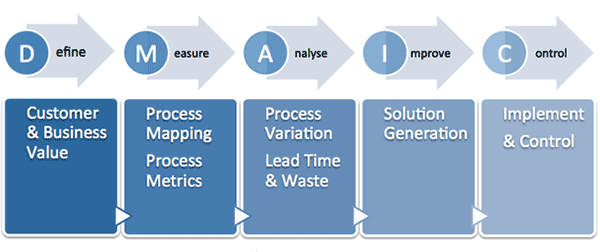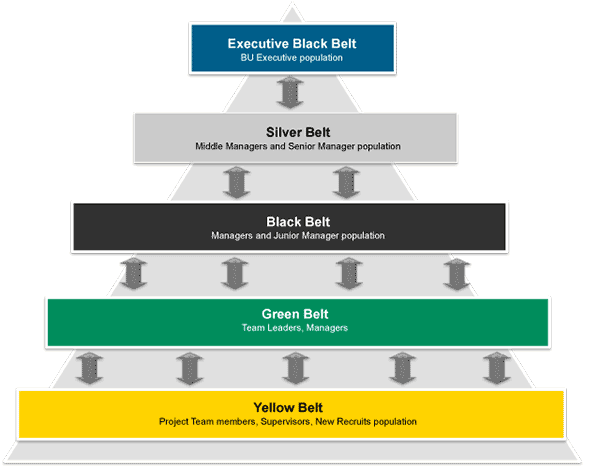Whether it concerns Six Sigma, Lean Manufacturing or Supply Chain issues, Lean Six Sigma is always the basic structure of our approach. Lean Six Sigma is a profitability improvement methodology focused on making decisions based on relevant information and evidence.
Lean Six Sigma is also a management style based on a structured dedicated project management organization. An objective of six sigma is to optimize processes and move product or service outputs permanently inside customer requirements.
In recent years, Six Sigma programs have become accepted as a way to make businesses effective and efficient. Several companies, including GE and AlliedSignal, saved billions of dollars with this approach, which led to increased profits.
Phases of the method

- Define: Clarify targets, scope of the project and the activity plan, mapping current processes and determining what customers or segments of customers want
- Measure: Collecting information on the process. Data logging, process scans and benchmarking is used
- Analyze: Analysing processes and data and finding causes
- Improve: Finding solutions like production adaptations, new process settings, service concepts and distribution concepts Well-known solutions, best practice and reference models are used
- Control: Provide the organisation with measures to keep the improved process under control
- Reinforce: Capitalise the improvement by ‘learning the lessons’ and establishing process re-assessment for continuous improvement.
Our Approach
Growing improvement competences and culture on a massive scale through training, qualification and coaching of Black Belts (BB) to engage all of your people in this drive for continual process improvement with a strong on Change Management.
Deploying one unified methodology, language and tool kit to promote integration and common ways of working with respect to performance improvement and to progressively reduce your dependence on external consultants.
This is about…
- Deploying a unique methodology and toolkit for sustainable performance Improvement
- Developed beyond the Best of GE and Toyota, customised for you
- Applicable to incremental and breakthrough Improvements
- Applicable to processes in all function
It is not …
- A copy of General Electric 6 Sigma
- A copy of Toyota Lean
- Only for Manufacturing
- Only for Quality
- Only for High Volume process
Change Management – Our Definition
- Change Management is defined as the processes to take into account all human and social aspects of the change from the launch of the project to its end
- It ensures the adequate involvement of the people concerned in the definition, communication and implementation of the new solution to secure “Buy-in”
- It covers a range of activities tightly embedded with Project Management activities
- Listen to the people concerned and continually communicate
Improvement – A holistic approach
The Lean Six Sigma Black Belt develops a specific set of skills and knowledge which need to be learned and practiced to support sustainable performance improvement. The programme includes ‘project management’ & ‘change management’ skills.
Training structure and contents
Session 1
| Content | Duration (days) |
|---|---|
| Project Reviews | 0.5 |
| Executive Belt introduction | 0.5 |
| Process Improvement Fundamentals | 2.0 |
| Change Management | 0.25 |
| Project Management | 0.25 |
| Fundamentals tool Kit (FMEA, 5S, error proofing and Green Belt exam) | 1.0 |
Session 2
| Content | Duration (days) |
|---|---|
| Project Reviews | 0.5 |
| Customer and Business Value | 0.5 |
| Process Mapping and Metrics | 0.75 |
| Lead Time & Waste | 1.25 |
| Workshops/Teams/People Management | 1.0 |
Session 3
| Content | Duration (days) |
|---|---|
| Project Reviews | 0.5 |
| Process Variation | 1.0 |
| Solution Generation | 0.75 |
| Implement and Control | 1.0 |
| Process Assessment | 0.25 |
| Materials Review | 0.5 |
Coaching and Practice
| Content | Duration (days) |
|---|---|
| Project Reviews | 0.5 |
| Coaching and Practice (on location) | 1.0 |
| Black Belt Exam | 0.5 |
Qualifications

Executive Black Belt ( 0.5 day)
This training provides an initial overview of the Lean Six Sigma method including the advantages, the disadvantages and pitfalls. Participants learn about the DMAIC method. The Executive Black Belt assumes the role of Champion.
At the end of the training the participant is able to:
- achieve company objectives through Lean Six Sigma DMAIC
- participate in Steering Committee meetings
- ensure that the project teams have sufficient time to complete the project
- monitor project achievements.
Silver Belt ( 3 days )
This training provides an initial overview of the Lean Six Sigma method including the advantages, the required support and the required commitment at the management level. Participants learn about the DMAIC method.
The Silver Belt assumes the role of the Project Sponsor.
At the end of the training the participant is able to:
- sponsor Improvement Projects through Lean Six Sigma DMAIC
- conduct regular project reviews
- help project managers by removing organisational obstacles
- determine Business Cases for the project.
Black Belt ( 20 days )
This training has two components: a practical part and a theoretical part. For certification both parts are required. The practical part deals with the successful realisation of a Lean Six Sigma Black Belt project. The theoretical part includes training over a period of 5 months.
During the course, along with the coaching, participants study the course material. At the end of the training period, a theoretical and practical examination is required to determine whether the candidate has acquired sufficient knowledge of Lean Six Sigma.
Upon successful completion of the training the participant is able to:
- lead teams in applying the Lean Six Sigma DMAIC
- prioritize improvements which have the largest impact
- define project improvements
- measure input and output to generate significant data points
- analyze data to determine causes of variance
- improve processes to minimise variance
- review processes to eliminate unwanted side effects and to anchor improvements.
Green Belt ( 7 days )
This training has two components: a practical part and a theoretical part. For certification both parts are necessary. The practical part involves successfully supporting a Lean Six Sigma project. The theoretical part includes the relevant training along with an assessment to determine whether the candidate has acquired sufficient knowledge of Lean Six Sigma.
At the end of the training the participant is able to:
- support teams in applying the Lean Six Sigma DMAIC
- define project improvements
- measure input and output to generate significant data points
- improve the process to minimise variance.
Yellow Belt ( 3 days )
This training’s main component is a practical part supported by theory, and ideal for participants who want to get more into Lean Six Sigma. For certification a brief examination is required. The Yellow Belt training can be a great preparation for the Green Belt training, although not obligatory. The practical part concerns successfully supporting the change and improved process during a Lean Six Sigma project. The theoretical part is included in all workshops. An assessment is included to determine whether the candidate has sufficient knowledge of Lean Six Sigma tools.
At the end of the training the participant is able to:
- support teams in applying the Lean Six Sigma DMAIC
- thoroughly understand how the major Lean Six Sigma tools are employed
- measure input and output, analyse data and determine durable solutions
- improve the process to minimise variance.